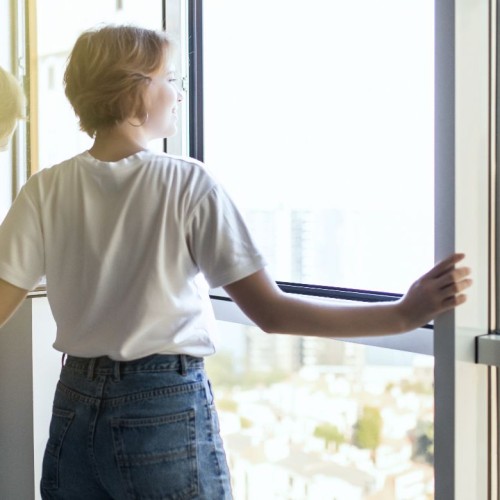Your home is more than a peaceful haven; it’s also the place where you spend most of your time. But did you know that pollutants such as mould and dust can affect indoor air quality? Studies show that the air in your house or apartment is up to 10 times more polluted than the air outside. Fortunately, there are ways to eliminate harmful airborne particles.
Why is good air quality important?
If you have a chronic illness, such as asthma, indoor pollution is one of your worst enemies. Pollutants in the air can exacerbate your symptoms.
Exposure to pollutants is bad for you even if you’re in perfect health. If the air is too polluted, you may experience flu-like symptoms, headaches, dizziness, or nausea.
What’s more, cases of conjunctivitis, shortness of breath, and fatigue have been reported among people exposed to pollutants.

Five ways to improve indoor air quality
While there are many sources of indoor pollution, there are also a number of simple ways to eliminate them from your home.
Getting rid of mould
Do you know how much moisture there is in your home? If the answer is no, head to your local hardware store and get a hygrometer. It can calculate the humidity level in the air. Some air exchangers and central ventilation systems can also do this.
Ideally, home humidity levels should be 50% in the summer and 30% in the winter. When levels exceed these guidelines, the risk of mould—microscopic fungi that appear as black or white spots on walls and ceilings—increases.
Regularly using the fan in your bathroom will significantly reduce humidity levels. For best results, run the fan for at least 20 minutes after bathing or showering. Turning on the range hood will also help reduce humidity in the house when you’re cooking.
If your bathroom fan or range hood doesn’t seem to be drawing in moisture, the ducts leading outside may not be properly connected. It’s also possible that the fans have simply reached the end of their useful life; it may be time to replace them!
Some areas in your house, such as the basement, are naturally more humid. Placing a dehumidifier in these rooms is a great solution. For best results, don’t forget to empty the water tray regularly: it can fill up quickly when humidity levels are high!
An air purifier is another device that helps clean the air in your home. Purifiers use various technologies and filters to absorb many of the pollutants and allergens found in the air. Some can even eliminate bad odours.

Maintaining your equipment
Do you have an air exchanger? That’s great news! Air exchangers help improve the air quality in your home. However, it’s important to clean or change the filters with each change of season, at minimum. Otherwise, your unit won’t operate at full capacity and may let through particles or pollutants that can be harmful to your health. Be sure to do the same if you have a central air conditioning system or an air purifier.
It’s also important to have your vents professionally cleaned at least once every five years. Over time, dust and dirt collect in these areas, reducing the quality of your indoor air.
Stay on top of your cleaning routine
Sometimes, simply vacuuming and dusting can dramatically improve the air quality of a room. Cleaning removes dust, pet hair, and allergens from floors and furniture. When the weather permits, consider opening the windows to air out the house and avoid breathing in airborne particles.
If you need to use cleaning products, choose biodegradable and natural options. Unlike many ordinary cleaning products, they don’t release contaminants that are harmful to the lungs or skin.
Limit the use of air fresheners, which are often made with toxic substances. Instead, try using essential oil diffusers, or strike a match to get rid of bad odours in the bathroom.
To avoid constant cleaning, consider removing your shoes when you come inside. You’ll be leaving a lot of bacteria and dirt outside if you do.
Watch out for radon and lead
Radon is a radioactive gas that can seep through your home’s foundation. It’s invisible to the naked eye and can only be detected with a dosimeter. Radon is dangerous in excessive quantities: it’s one of the known causes of lung cancer.
If you detect radon in your home, call a specialist. They will likely advise you to carry out certain repairs, such as sealing any cracks in your foundation.
Was your home built before 1960? Some of the paint on the walls may contain lead. If this is the case, call in a professional to safely dispose of it.
Take care with fireplaces
There’s nothing cozier than sitting by the fire on a cold day! That said, gas and wood-burning fireplaces emit pollutants, including the following:
- Carbon monoxide
- Nitrogen dioxide
- Volatile organic compounds, or VOCs
To reduce the risk of air pollution, make sure your fireplace meets the latest government standards. Newer models are generally more efficient and release less smoke into the air.
Avoid burning these non-compliant materials:
- Plywood
- Plastic
- Magazines or glossy paper
- Treated or painted wood
- Wood scraps
When burned, these items release chemicals that may be hazardous to your health. Maintain your fireplace regularly and have your chimney swept at least once a year.
Bring in help if needed
Whether or not you have a chronic disease, cleaning the air in your home will help you breathe easier. If you don’t know where to start, call a home inspector or a firm that specializes in air testing.
Things to remember
- The ideal humidity level in a house is 50% in the summer and 30% in the winter.
- Regular maintenance keeps filters working efficiently and reduces the amount of pollutants in the air.
- Radon is a radioactive gas that can only be detected with a dosimeter. Doing certain repairs, such as filling cracks in the foundation, can usually reduce its concentration indoors.
- For the best air quality, choose a fireplace that meets government standards and don’t burn non-compliant materials.

